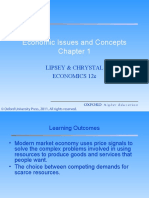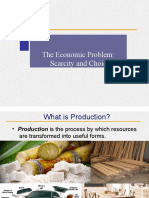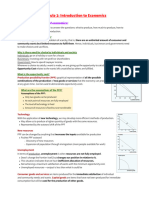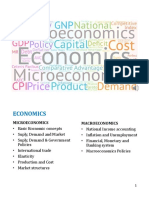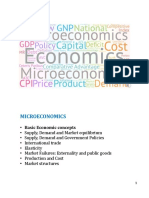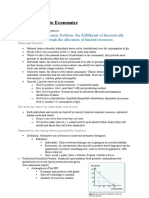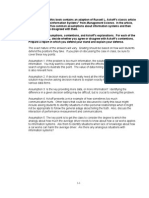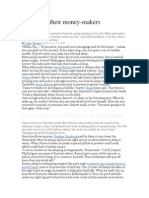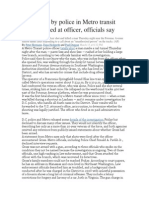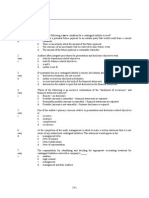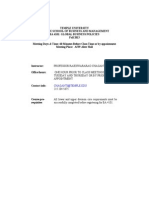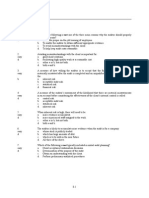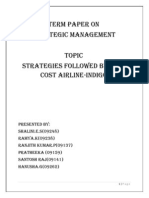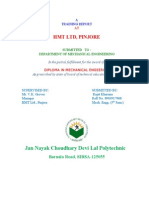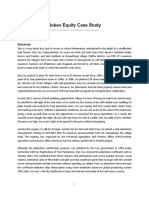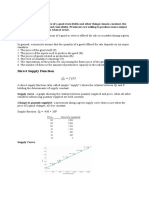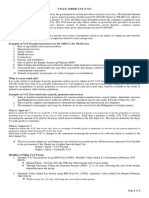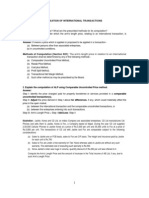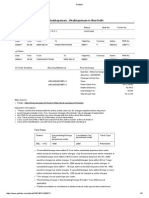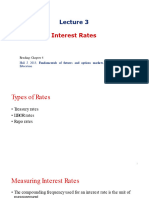Chapter 2: The Economic Problem
The production possibilities frontier (PPF) is the boundary between those combinations of goods
and services that can be produced and those that cannot
o Take two goods at a time and look at the model economy in which everything remains
the same (ceteris paribus) except the two goods being considered
Any point on the frontier and any point inside it are attainable. Any point outside the PPF is
unattainable.
We achieve production efficiency if we cannot produce more of one good without producing
less of some other good. Points on the frontier are efficient. Any point inside the PPF is
inefficient. At such point it is possible to produce more of one good without producing less of
the other good. At these points, resources are either unemployed or misallocated.
Every choice along the PPF involves a tradeoff:
o i.e. we give up some colas for more pizzas and vice versa
o as we produce more pizzas, the quantity of cola we can produce decreases.
Opportunity cost of a pizza is the amount of cola forgone.
o The quantity of pizzas increases by 1 million while the quantity of cola produced
decreases by 5 million. The fifth 1 million pizzas = 5 million colas. Therefore, one of the
pizzas = 5 cans of cola, at the same time, one can of cola = 1/5 of a pizza.
Opportunity Cost is a Ratio: opportunity cost of a can of cola is the inverse of the opportunity
cost of a pizza.
Increasing the Opportunity Cost:
Because resources are not equally productive in all activities, the PPF bows outward. This
bow means that as the quantity produced of each good increases, so does its opportunity
cost.
The PPF determines opportunity cost. The marginal cost of a good or service is the opportunity cost of
producing one more unit of it.
Marginal benefit of a good or service is the benefit received from consuming one more unit
of it. We measure marginal benefit by the amount a person is willing to pay for an additional
unit of a good or service.
When we cannot produce more of any one good without giving up some other good, we have achieved
production efficiency. We are producing at a point on the PPF. When we cannot produce more of any
one good without giving up some other good that we value more highly, we have achieved allocative
efficiency. The point of allocative efficiency is the point on the PPF at which marginal benefit equals
marginal cost.
If marginal benefit > marginal cost, we must produce more of the good. For instance, we are
producing too few pizzas and are better off moving along the PPF to produce more pizzas.
If marginal cost > marginal benefit, we get more value from our resources by producing
fewer pizzas and are better off moving along the PPF to produce fewer pizzas.
If marginal cost = marginal benefit, we are producing the efficient quantities of pizzas and
colas. We cannot get more value from our resources.
The expansion of production possibilities an increase in the standard of living is called economic
growth. Two key factors influence this economic growth:
Technological change: development of new goods and better ways on producing these goods
Capital accumulation: growth of capital resources, which includes human capital
A person has a comparative advantage in an activity if that person can perform the activity at a lower
opportunity cost than anyone else. A person has an absolute advantage if that person is more
productive than others. Absolute advantage involves comparing productivities while comparative
advantage involves comparing opportunity costs.
Lizs Opportunity Cost of producing 1 smoothie is 1 salad; and 1 salad is 1 smoothie. Joes Opportunity
Cost of producing 1 smoothie is 5 salads; and 1 salad is 1/5 of a smoothie.
Lizs Comparative Advantage:
o Lizs Opportunity cost of a smoothie is 1 salad.
o Joes Opportunity cost of a smoothie is 5 salads.
o Lizs opportunity cost of a smoothie is less than Joes.
So Liz has a comparative advantage in producing smoothies.
Joes Comparative Advantage:
o Joes opportunity cost of a salad is 1/5 of a smoothie.
o Lizs opportunity cost of a salad is 1 smoothie.
o Joes opportunity cost of a salad is less than Lizs.
So Joe has a comparative advantage in producing salads.
Achieving Gains from Trade:
Liz and Joe produce the good in which they have a comparative advantage:
o Liz produces 30 smoothies and 0 salads
o Joe produces 30 salads and 0 smoothies
Liz and Joe trade:
o Liz sells Joe 10 smoothies and buys 20 salads
o Joe sells Liz 20 salads and buys 10 smoothies
After trade:
o Liz has 20 smoothies and 20 salads
o Joe has 10 smoothies and 10 salads
Gains from trade:
o Liz gains 5 smoothies and 5 salads an hour
o Joe gains 5 smoothies and 5 salads an hour
To reap the gains from trade, the choices of individuals must be coordinated. To make
coordination work, four complimentary social institutions have evolved over the centuries:
A firm is an economic unit that hires factors of production and organizes those
factors to produce and sell goods and services
A market is any arrangement that enables buyers and sellers to get information and
do business with each other
Property rights are the social arrangements that govern ownership, use, and
disposal of resources, goods or services
Money is any commodity or token that is generally acceptable as a means of
payment
Factors of production and goods and services flow in one direction, while money flows in the opposite
one.
Markets coordinate individual decisions through price adjustments.
Chapter 4: GDP, uses and limitations
Households sell and firms buy the services of labor, capital, and land in factor markets.
o Firms pay income to households; wages for labor services; interest for capital; and
rent for use of land; also entrepreneurship receives profit.
Firms sell and households buy consumer goods and services in the goods market.
o Consumer expenditure is the total payment for consumer goods and services, shown by
the flow labeled C
o The purchase of new plant, equipment, and buildings and the additions to inventories
are investment, shown by I
o Governments buy goods and services from firms and their expenditure on goods and
services is called government expenditure (shown as G)
Governments finance expenditure with taxes and pay financial transfers to
households, such as unemployment benefits, and pay subsidies to firms
Firms in the US sell goods and services to the rest of the world exports and buy goods and
services from the rest of the world imports
o The value of exports (X) minus the value of imports (M) is called net exports (X-M)
o When net exports are positive, flow of goods and services is from the US to the rest of
the world
o When net exports are negative, flow of goods and services is from the rest of the world
to the US
GDP Equals Expenditure Equals Income
Total Expenditure on final goods and services equals GDP:
o GDP = C + I + G + X-M
Aggregate Income equals the total amount paid for the use of factors of production: wages,
interest, rent, and profit
Firms pay out all their receipts from the sale of final goods so income equals expenditure
o Y = C + I + G + (X-M)
Domestic
Domestic Product is production within a country. Contrasts with national product, which is the
value of goods and services produced anywhere in the world by the residents of a nation
Gross
Gross Product means before deducting the depreciation of capital. Opposite of gross is net,
which means after the deducting of depreciation of capital
Depreciation is the decrease in the value of a firms capital that results from wear and tear and
obsolescence
Gross Investment is the total amount spent on purchases of new capital and on replacing depreciated
capital
Net Investment is the decrease in the value of the firms capital
Net Investment = Gross Investment Depreciation
The Expenditure Approach
Measures GDP as the sum of consumption expenditure, investment, government expenditure
on goods and services and net exports
The Income Approach
Measures GDP by summing the incomes that firms pay households for the factors of production
they hire wages for labor, interest for capital, rent for land, and profit for entrepreneurship
Compensation of employees is the payments for labor services. It is the sum of net wages plus taxes
withheld plus social security and pension fund contributions
Net Operating Surplus is the sum of other factor incomes. It includes net interest, rental income,
corporate profits, and proprietors income
Two adjustments must be made to get GDP:
1. Indirect taxes less subsidies are added to get from factor cost to market prices
2. Depreciation is added to get from net domestic income to gross domestic income
Real GDP is the value of final goods and services produced in a given year when valued at the prices of a
reference base year
Nominal GDP is the value of goods and services produced during a given year valued at the prices that
prevailed in that same year
Economists use real GDP for two main purposes:
o To compare the standard of living over time
o To compare the standard of living across countries
Real GDP per person is real GDP divided by the population
The value of real GDP when all the economys labor, capital, land, and entrepreneurial ability are fully
employed is called Potential GDP
A business cycle is a periodic but irregular up-and-down movement of total production and other
measures of economic activity
Every cycle has two phases:
o (1) Expansion and (2) Recession
And two turning points:
o (1) Peak and (2) Trough
Two problems arise in using real GDP to compare living standards across countries:
1. The real GDP of one country must be converted into the same currency units as the real GDP of
the other country
2. The goods and services in both countries must be valued at the same prices
Limitations of Real GDP
Some of the factors that influence the standard of living and that are not part of GDP are:
Household production
Underground economic activity
Leisure time
Environmental quality
Chapter 5: Monitoring Jobs and Inflation
Why unemployment is a problem
Unemployment results in:
o Lost Incomes and Production
o Lost Human Capital
US Labor force population divides into two groups:
1. Working-age population: the number of people aged 16 years and older who are not in jail,
hospital, or some other institution
2. People too young to work (under 16 years) or in institutional care
Working-age population is divided into two groups:
1. People in the labor force
2. People who are not
The labor force is the sum of employed and unemployed workers.
To be counted as unemployed, one must be in one of the following three categories:
1. Without work but has made specific efforts to find a job within the previous four weeks
2. Waiting to get called back to a job from which he or she has been laid off
3. Waiting to start a new job within 30 days
Three Labor Market Indicators
The unemployment rate
The employment-to-population ratio
The labor force participation rate
Example Economy:
Population: 314 million
Working-age Population: 243.4 million
Labor Force: 155 million
Employed: 142.2 million
Unemployed: 12.8 million
The Unemployment Rate is the percentage of the labor force that is unemployed.
Calculated by: (number of people unemployed / labor force) * 100
(12.8 / 155) * 100 = 8.2 %
The unemployment rate increases in a recession and reaches its peak value after the recession
The Employment-to-Population Ratio is the percentage of the working-age population who have jobs.
Calculated by: (employment / working-age population) * 100
(142.2/243.4) * 100 = 53.4 %
The Labor Force Participation Rate is the percentage of the working-age population who are members
of the labor force.
Calculated by: (labor force / working-age population) * 100
(155/243.4) * 100 = 63.7 %
The official measure of unemployment is an imperfect one because it excludes:
Marginally attached workers: a person who currently is neither working nor looking for work
but has indicated that he or she wants and is available for a job and has looked for work
sometime in the recent past. A discouraged worker is a marginally attached worker who has
stopped looking for a job because of repeated failure to find one.
Part-time workers who want full-time jobs: these workers are called economic part-time
workers and they are partly employed
The most costly form of unemployment is long-term unemployment that results from job loss.
The BLS reports six alternative measures of the unemployment rate: two narrower than the official
measure and three broader ones:
Narrower measures U1 and U2 focus on the personal cost of unemployment
Broader measures U4, U5, and U6 focus on assessing the full amount of unused labor
resources
o U1: Those unemployed for 15 or more weeks
o U2: Unemployed job losers
o U3: The official unemployment rate
o U4: U3 + Discouraged workers
o U5: U4 + Other marginally attached workers
o U6: U4 + Part-time workers who want full time jobs
All measures increase together in recession.
Frictional Unemployment is unemployment that arises from normal labor market turnover. Increases in
the number of people entering and reentering the labor force and increases in unemployment benefits
raise frictional unemployment. It is a permanent and healthy phenomenon of a growing economy.
Structural Unemployment is unemployment created by changes in technology and foreign competition
that change the skills needed to perform jobs or the locations of jobs. Structural unemployment lasts
longer than frictional unemployment.
Cyclical Unemployment is the higher than normal unemployment at a business cycle trough and the
lower than normal unemployment at a business cycle peak. A worker who is laid off because the
economy is in a recession and is then rehired when the expansion begins experiences cyclical
unemployment.
Natural Unemployment Rate is natural unemployment as a percentage of the labor force. Natural
unemployment is the unemployment that arises from frictions and structural change when there is no
cyclical unemployment. Natural Unemployment is all structural and frictional unemployment.
Full employment is defined as the situation in which the unemployment rate equals the natural
unemployment rate. When the economy is at full employment, there is no cyclical unemployment or,
equivalently, all unemployment is frictional and structural.
Real GDP minus potential GDP is the output gap.
We are interested in the price level because we want to:
1. Measure the inflation rate or the deflation rate
2. Distinguish between money values and real values of economic variables
Unpredictable inflation or deflation is a problem because it:
Redistributes income and wealth
Lowers real GDP and employment
Diverts resources from production
Consumer Price Index, or CPI, measures the average of the prices paid by urban consumers for a fixed
basket of consumer goods and services. Defined to equal 100 for the reference base year.
CPI = (cost of basket at current-period prices / cost of basket at base-period prices) * 100
The Inflation Rate is the percentage change in the price level from one year to the next
Inflation rate = [(CPI this year CPI last year) / CPI last year] * 100
The Biased CPI
The CPI might overstate the true inflation rate for four reasons:
o New Goods Bias: new goods that were not available in the base year appear and, if they
are more expensive than the goods they replace, they put an upward bias into the CPI
o Quality Change Bias: quality improvements occur every year. Part of the rise in the price
is payment for improved quality and is not inflation. The CPI counts all the price rise as
inflation.
o Commodity Substitution Bias: the market basket of goods used in calculating the CPI is
fixed and does not take into account consumers substitutions away from goods whose
relative prices increase.
o Outlet Substitution Bias: as the structure of retailing changes, people switch to buying
from cheaper sources, but the CPI, as measured, does not take account of this outlet
substitution.
Chapter 8: Money
Money is any commodity or token that is generally acceptable as a means of payment
Money has three other functions:
1. Medium of exchange: a means of exchange is an object that is generally accepted in exchange
for goods and services. In the absence of money, people would need to exchange goods and
services directly, which is called barter (costly)
2. Unit of Account is an agreed measure for stating the prices of goods and services
3. As a store of value, money can be held for a time and later exchanged for goods and services
Money is the US consists of:
Currency: notes and coins held by households and firms
Deposits of banks and other depository institutions
The two official measures of money in the US are M1 and M2
M1 consists of currency and travelers checks and checking deposits owned by individuals and
businesses
M2 consists of M1 plus time, saving deposits, money market mutual funds, and other deposits
All the items in M1 are means of payment. They are money.
Some saving deposits in M2 are not means of payment they are called liquid assets
Liquidity is the property of being instantly convertible into a means of payment with little loss of value
Checks and credit cards are NOT money
A deposit institution is a firm that takes deposits from households and firms and makes loans to other
households and firms.
Deposits at three institutions make up the nations money:
Commercial banks: a commercial bank is a private firm that is licensed by the Comptroller of the
Currency or by a state agency to receive deposits and make loans
Thrift institutions: savings and loan associations, savings banks, and credit unions are called
thrift institutions
Money market mutual funds: a money market mutual fund is a fund operated by a financial
institution that sells shares in the fund and holds assets such as US Treasury bills
Interest rate at which banks lend exceeds the interest rate that they pay on deposits
A commercial bank puts the depositors funds into four types of assets:
1. Reserves: notes and coins in its vault or its deposit at the Federal Reserve
2. Liquid Assets: US government treasury bills and commercial bills
3. Securities: longer-term US government bonds and other bonds such as mortgage-backed
securities
4. Loans: commitments of fixed amounts of money for agreed-upon periods of time
Depository Institutions provide four benefits:
Create liquidity
Pool risk
Lower the cost of borrowing
Lower the cost of monitoring borrowers
The aim of financial innovation the development of new financial products is to lower the cost of
deposits or to increase the return from lending. Two influences on financial innovation are:
1. Economic Environment
2. Technology
The Federal Reserve System (the Fed) is the central bank of the US. A central bank is the public
authority that regulates a nations depository institutions and controls the quantity of money. The Feds
goals are to keep inflation in check, maintain full employment, moderate the business cycle, and
contribute toward achieving long-term growth.
The key elements in the structure of the Fed are:
The Board of Governors
The regional Federal Reserve Banks (12 regions)
The Federal Open Market Committee (main policy-making group)
Feds largest and most important asset is the US government securities. Largest and most important
liabilities are Federal Reserve notes in circulation and banks deposits. The sum of Federal Reserve
notes, coins, and depository institutions deposits at the Fed is the monetary base.
To achieve its objectives, the Fed uses three main policy tools:
Open Market operations: an open market operation is the purchase or sale of government
securities by the Fed from or to a commercial bank or the public. When the Fed buys securities,
it pays for them with newly created reserves held by the banks. When the Fed sells securities,
they are paid for with reserves held by banks. So open market operations influence banks
reserves.
Last Resort loans: the Fed is the lender of last resort, which means the Fed stands ready to lend
reserves to depository institutions that are short of reserves
Required reserve ratios: the Fed sets the required reserve ratio, which is the minimum
percentage of deposits that a depository institution must hold as reserves. The Fed rarely
changes this ratio.
The quantity of deposits that banks can create is limited by:
The monetary base: the sum of Federal Reserve notes, coins, and banks deposits at the Fed.
The size of the monetary base limits the total quantity of money that the banking system can
create because (1) banks have desired reserves and (2) households and firms have desired
currency holdings. And both these desired holdings of monetary base depend on the quantity of
money
Desired reserves: the desired reserve ratio is the ratio of the banks reserves to total deposits
that a bank plans to hold
Desired current holding
Excess reserves = actual reserves desired reserves
The Influence on Money Holding
The quantity of money that people plan to hold depends on fair main factors:
o The price level a rise in the price level increases the quantity of nominal money but
doesnt change the quantity of real money that people plan to hold
o Nominal Money is the amount of money measured in dollars. Real money equals
nominal money / price level. The quantity of nominal money demanded is proportional
to the price level a 10 percent rise in the price level increases the quantity of nominal
money demanded by 10 percent
o The Nominal Interest Rate the opportunity cost of holding wealth in the form of
money rather than an interest-bearing asset. A rise in the nominal interest rate on other
assets decreases the quantity of real money that people plan to hold
o Real GDP an increase in real GDP increases the volume of expenditure, which
increases the quantity of real money that people plan to hold
Financial Innovation that lowers the cost of switching between the money and interest-bearing assets
decreases the quantity of real money that people plan to hold
The demand for money is the relationship between quantity of real money demanded and the nominal
interest rate when all other influences on the amount of money that people wish to hold remains the
same.
Money Market Equilibrium occurs when the quantity of money demanded equals the quantity of
money supplied.
The quantity of money theory is the proposition that, in the long run, an increase in the quality of
money brings an equal percentage increase in the price level. The quality theory of money is based on
the velocity of circulation and the equation of exchange.
Chapter 10: Aggregate Demand and Aggregate Supply
The quantity of real GDP supplied is the total quantity that firms plan to produce during a given period.
Aggregate Supply is the relationship between the quantity of real GDP supplied and the price level.
Long-term aggregate supply
Short-term aggregate supply
Long-run Aggregate Supply is the relationship between the quantity of real GDP supplied and the price
level when real GDP equals potential GDP. Potential GDP is independent of the price level. So the long-
run aggregate supply curve is vertical at potential GDP.
Short-run Aggregate Supply is the relationship between the quantity of real GDP supplied and the price
level when the money wage rate, the prices of other resources, and potential GDP remain constant.
Short-run aggregate supply is upward sloping.
Changes in Aggregate Supply
Aggregate Supply changes if an influence on production plans other than the price level
changes. These factors include:
o Changes in potential GDP
o Changes in money wage rate (and other factor prices)
Changes in Potential GDP
When Potential GDP increases, both the long-run aggregate supply curve and short-run aggregate
supply curve shift rightward.
Potential GDP changes for three reasons:
An increase in the full-employment quantity of labor
An increase in the quantity of capital (physical or human)
An advance in technology
Aggregate Demand is the relationship between the quantity of real GDP demanded and the price level.
The aggregate demand curve (AD) plots the quantity of real GDP demanded against the price level.
Changes in Aggregate Demand
A change in any influence on buying plans other than the price level changes aggregate demand. The
main influences on aggregate demand are:
Expectations: about future income, future inflation, and future profits
Fiscal policy: the governments attempt to influence the economy by setting and changing taxes,
making transfer payments, and purchasing goods and services. The Feds attempt to influence
the economy by changing the interest rate and adjusting the quantity of money is monetary
policy
The World Economy: influences aggregate demand in two ways:
1. A fall in the foreign exchange rate lowers the price of domestic goods and services
relative to foreign goods and services, which increases exports, decreases imports, and
increases aggregate demand
2. An increase in foreign income increases the demand for US exports and increases
aggregate demand
An above full-employment equilibrium is an equilibrium in which real GDP exceeds potential GDP
A full-employment equilibrium is an equilibrium in which real GDP equals potential GDP
A below-employment equilibrium is an equilibrium in which potential GDP exceeds real GDP
Macroeconomics can be divided into three broad schools of thought:
A classical macroeconomist believes that the economy is self-regulating and always at full-
employment. A new classical view is that business cycle fluctuations are the efficient responses
of a well-functioning market economy that is bombarded by shocks that arise from the uneven
pace of technological change
A Keynesian macroeconomist believes that left alone, the economy would rarely operate at full
employment and that to achieve and maintain full employment, active help from fiscal policy
and monetary policy is required. A new Keynesian view holds that not only is the money wage
sticky but also are the prices of goods
A monetarist is a macroeconomist who believes that the economy is self-regulating and that it
will normally operate at full employment, provided that monetary policy is not erratic and that
the pace of money growth is kept steady









